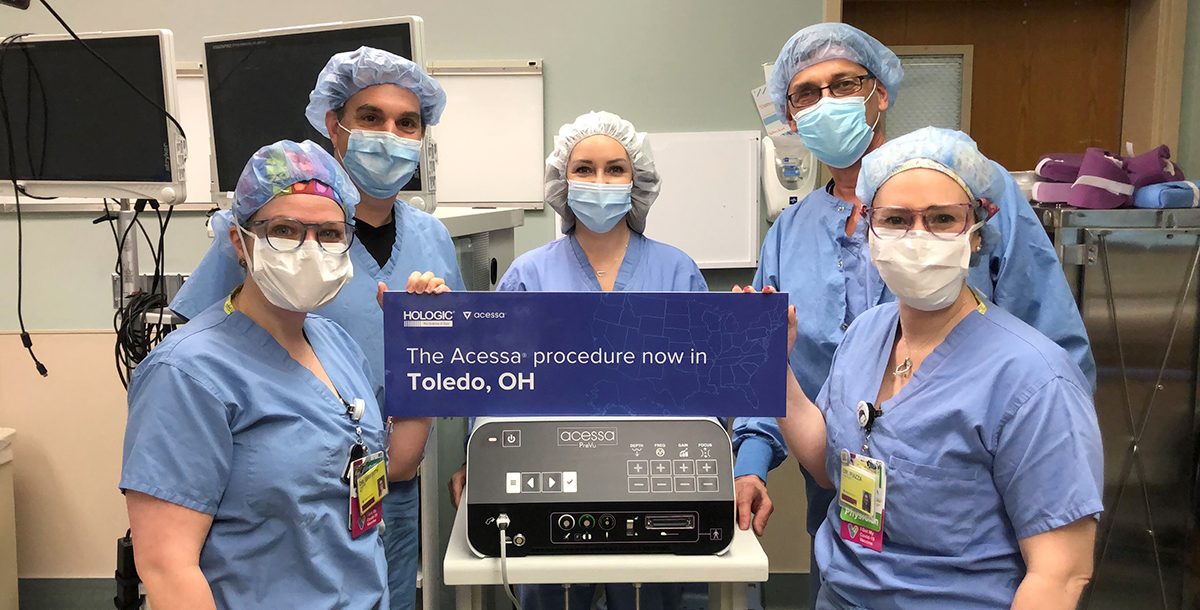Uterine fibroids are a common condition that many women experience. The signs of uterine fibroids, however, vary from woman to woman. Uterine fibroids are made of muscle and fibrous tissue, while their size can range from tiny, undetectable spots to large masses that can cause noticeable symptoms.
If you recognize any signs of uterine fibroids, make an appointment with your gynecologist. They can order testing you may need and determine treatment if necessary.
What are uterine fibroids?
Uterine fibroids are benign tumors that grow in or on the uterus, often during childbearing years. They are also referred to as uterine leiomyomas or myomas and usually are harmless. However, painful symptoms are what drive women to see their health care provider.
“Fibroids are very common, occurring in 60 to 70 percent of women at any point in their lifetime,” shares Tracy Griffith, MD, an OB-GYN in our Toledo market. “It is currently the most common indication for hysterectomy in the United States. Treatment options have typically been limited to medication or invasive surgery and they are a frustrating problem for both patients as well as clinicians.”
What causes fibroids?
Who is at risk of fibroids and the reason they develop remains unclear. However, clinical research indicates that hormone levels of estrogen and progesterone control fibroids. There may be a hereditary component as well, as they tend to run in families and are more common in certain ethnic groups, such as Black women.
The most important thing to remember is that fibroids are very common and don’t increase the risk of uterine cancer. In fact, they almost never develop into cancer.
Common signs of uterine fibroids
While fibroids are often harmless, they become problematic when painful symptoms occur.
While symptoms for fibroids can be extremely diverse and are often chalked up to period pain, here are a few symptoms to look for:
- Heavy or prolonged menstrual periods: One of the most common signs of fibroids is prolonged or heavy menstrual bleeding. If you’re experiencing periods that last longer than usual or require more than one pad or tampon every hour for several hours, fibroids could be the cause. Some women even experience clots during their periods.
- Pelvic pain or pressure: Fibroids can cause a feeling of heaviness or pressure in the pelvic area. This can be uncomfortable and may even cause pain during certain activities, such as exercising or having sex. The pain might be intermittent or persistent, depending on the size and location of the fibroids.
- Frequent urination: Large fibroids, especially those that grow near the bladder, can put pressure on it. This may lead to a frequent urge to urinate, even when the bladder isn’t full. If you’re running to the bathroom more often than usual, it could be a sign of fibroids.
- Back or leg pain: Fibroids that press against nerves in the lower back or legs can lead to pain. The position of the fibroids may cause dull and aching pain or sharp and sudden pain. If the pain doesn’t go away with usual treatments like over-the-counter pain relievers, it’s worth checking in with your doctor.
- Constipation or bloating: When fibroids grow near the rectum, they can lead to constipation or a sensation of bloating. Some women report a feeling of fullness in the stomach area, even when they haven’t eaten much. This is because fibroids can exert pressure on the intestines, making it more difficult to pass stool.
- Painful intercourse: Fibroids can sometimes make sexual activity uncomfortable or painful. This can happen if a fibroid is in a spot where it pushes against the walls of the vagina or cervix during sex.
- Enlarged abdomen: In some cases, large fibroids can cause the abdomen to swell, making it look as though a woman is pregnant. While this is less common, it can be a sign of fibroids that need attention, especially if the abdominal bloating is sudden or severe.
How are fibroids diagnosed?
Sometimes, your health care provider can feel a fibroid during a standard pelvic exam. Typically, as part of a workup for abnormal bleeding or pelvic pain, your provider may request a pelvic ultrasound, which uses sound waves to create an image, or a more specialized test, like magnetic resonance imaging (MRI).
“Both of these options help identify the size and location of the fibroids,” Dr. Griffith says.
These non-invasive tests are generally safe and can help your doctor create the best treatment plan for you.
How are fibroids treated?
The threshold for treatment is when symptoms start interfering with daily activity. Thus, if fibroids are asymptomatic, they don’t necessarily require treatment.
For those women who are having symptoms, treatment options can vary depending on each patient’s unique needs. Treatment options can include:
- Medications: These may include hormone treatments to control bleeding or pain.
- Non-surgical procedures: Options like uterine artery embolization or MRI-guided focused ultrasound destroy or shrink fibroids without the need for surgery.
- Surgical options: If other treatments are ineffective, your provider may recommend surgery such as myomectomy (removal of fibroids) or, in rare cases, hysterectomy (removal of the uterus).
Innovative treatment we offer
A newer procedure that we offer at Mercy Health, depending on the individual’s symptoms, is called Acessa.
With Acessa, we utilize a laparoscopic ultrasound probe and radiofrequency ablation to destroy fibroid tissue by applying controlled heat energy through a small needle. The destroyed fibroid tissue changes consistency and shrinks over time.
“Acessa is such an excellent option for patients because it gives them the ability to have a very effective surgical procedure, with minimal recovery time and a very fast return to their daily activities,” Dr. Griffith shares. “Previous surgical treatments for fibroids have either required a large incision, or they have been associated with a very painful recovery requiring hospitalization. The ability to have more options to offer patients is very exciting.”
How we can help
Uterine fibroids are a common condition, and while they can cause discomfort, effective treatment options are available. Recognizing the signs of uterine fibroids is a necessary first step in getting a diagnosis.
If you notice any symptoms, make an appointment with your gynecologist. They can provide the best treatment option for you.
Learn more about the women’s health services we offer at Mercy Health.






